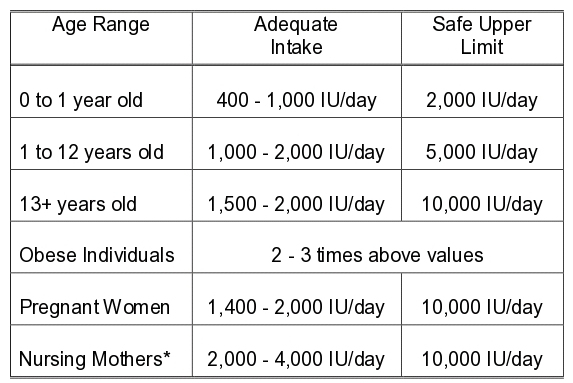If you are paying attention to nutrition or health-related news, you know that not a week goes by without some new findings coming out about the health benefits of vitamin D. However, there is also a lot of confusion about how much vitamin D each person needs as well as the best/safest way to achieve optimal vitamin D levels. The purpose of this post is to try and clear some of the confusion.
There are two major forms of vitamin D: Vitamin D2 (ergocalciferol) and Vitamin D3 (cholecalciferol). Either form is converted into the biologically active form (the form your body can use) of vitamin D by several reactions in the liver and kidneys. Supplemental vitamin D3 has been found to be much more easily utilized by the body than vitamin D2 (which is the form found in prescription forms of vitamin D).
Most of us have been told that we can get sufficient vitamin D from sun exposure on our skin; this turns out to be incorrect for most of us. The body does make vitamin D from exposure of the skin to the sun – most research indicates that exposure of the hands, arms and face to direct sunlight for 10 minutes will generate about 400 IU of vitamin D (sunblock drops that number to almost zero). Unfortunately, research is showing that most of us need much more than this to optimize our health and reap the many benefits of healthy vitamin D levels. In fact, it’s been estimated that almost every that lives north of Tennessee/Texas (the 37th parallel) that does not take vitamin D3 supplements is deficient in vitamin D.
Testing for 25-hydroxy vitamin D is the best way to determine your level and need. Even thought the standard range is absurdly large – ranging from 20-100 ng/ml, the healthy range of vitamin D has been shown to be 50-65 ng/ml for those that are in good health. If a person suffers from auto-immunity and/or chronic inflammation/pain, they should aim for 80-90 ng/ml as their target vitamin D level.
The Vitamin D counsel has proposed the following guidelines for vitamin D3 supplementation:

Researchers have found that most adults would benefit from between 1000-8000 IU/day of vitamin D3.
Here’s a general guide to help you determine how much vitamin D3 you should supplement:
| Daily Vitamin D Dose | Increases blood levels by: |
| 1,000 IU | 11.6 ng/ml |
| 10,000 IU | 58.5 ng/ml |
| 50,000 IU | 257.6 ng/ml |
For example, if I am a 154 lb. person and my baseline level is 20 ng/ml, I would need to supplement about 5000 IU of vitamin D3 everyday to achieve a goal of 60 ng/ml.
Note, vitamin D toxicity does not occur until 25-hydroxy vitamin D levels reach 200 ng/ml, so there is a large safety net built into these vitamin D recommendations.
With the widespread use of sunblock and inability to get adequate vitamin D from sun exposure, most people on the planet would benefit from supplementing vitamin D3. We like to use Bio-D-Mulsion Forte – 1 drop contains 2000 IU Vitamin D3, which makes dosing easy.
References
- Kennel, Kurt A. et al. Vitamin D Deficiency in Adults: When to Test and How to Treat. Mayo Clinic Proceedings , Volume 85 , Issue 8 , 752 – 758.
- Dawson-Hughes B, Heaney RP, Holick MF, et al. Estimates of optimal vitamin D status. Osteoporosis International. July 2005, Volume 16, Issue 7, pp 713-716.
- Barger-Lux MJ, Heaney RP, Dowell S, Chen TC, Holick MF. Vitamin D and its major metabolites: serum levels after graded oral dosing in healthy men. Osteoporos Int. 1998;8(3):222-30.



Hey Dr.Chad!
How long would you take the dose of Vitamin D to reach targeted levels? Using your example of 154# how long should it take to get from 20 to 60?
Hi Renee – thanks for the inquiry (and sorry for leaving this information out!) – this study was done over an 8 week time period.
Hope this helps!
Dr. Chad